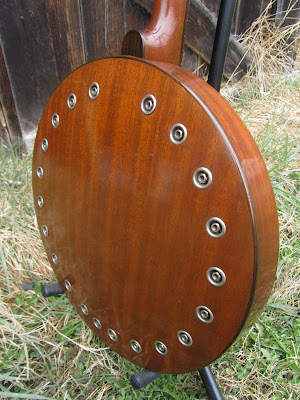c.1932 Weymann Style 50 "Megaphonic" Tenor Banjo

Notice that I'm a Weymann fan? Two Weymann tenors in the space of three blog posts.
These style 50 tenor banjos from the 1930s are fantastic "concert" instruments in that they do exactly what's required of a tenor banjo for backing horns or jazz combos -- cut through while sounding sweet and tight at the same time.
If you check the next post below (click for link) you can see some of the interior design on the rim, which shows off the "Megaphonic" rim design that Weymann made for their fancier, full-on resonator models. Suffice to say, the tonering on this is similar to a Vega "Little Wonder" type with a rolled ring in a spunover sleeve and gives a similar sweet, "open" voice. Coupled to the rugged and "open" footing of the rim, 23" long scale, and the big mahogany resonator, that means good volume and balance throughout with pretty excellent sustain.
If you check the next post below (click for link) you can see some of the interior design on the rim, which shows off the "Megaphonic" rim design that Weymann made for their fancier, full-on resonator models. Suffice to say, the tonering on this is similar to a Vega "Little Wonder" type with a rolled ring in a spunover sleeve and gives a similar sweet, "open" voice. Coupled to the rugged and "open" footing of the rim, 23" long scale, and the big mahogany resonator, that means good volume and balance throughout with pretty excellent sustain.

Here's an advert from the 1930 Weymann catalog. The only difference is that this 1932 model sports geared 2:1 tuner which are a lot easier to use than typical friction types.

My work included fixing a crack at the heel, a fret level/dress, new skin head, cleaning and hardware polishing, and full setup.
One of the joys of Weymanns is their adjustment and attachment mechanisms. On this banjo the neck is held in place with one big bolt and there's a small adjustment wheel at the top of the heel join that lets one adjust back-angle of the neck. This makes it really easy to dial in proper action without having to adjust a bridge's height.

Ah, yes, materials! Mahogany neck with a rosewood board. MOP dots in the neck.

Original adjustable Waverly tailpiece and nice original 3-foot Grover bridge. speaking of which -- aside from the head -- everything is original!

Note the pretty, and good quality, hardware.

You can see the adjuster in this photo. It's the hex thingie.

She's a beaut!

If you're wondering why only one string is wound in the photos, it's because at the moment I've been fooling around with it in low G uke tuning -- GCEA -- and liking it quite a bit. You can strum it or pick it and it sounds great either way.

The finish is in fantastic shape on this fella.

Rosewood headstock veneer, good bone nut, and cool multicolored Weymann label/decal.


Pretty mahogany! And it's not a veneer. It's solid.

I like these old 2:1 tuners. Ivoroid knobs.


Ah, yes, I should mention that one tensions the hooks & head on the back side, here, which at the same time makes sure the resonator sticks tight to the rim.



Pretty clean!



Here's my heel repair. All set to go.

Interesting -- probably pending on the rim design, I'd imagine.

...and here's its original case! Pitch pipe and neck angle adjuster wrench included.

Comments
http://www.leavingthisworld.com/weymann-serial-numbers-and-dating/#111